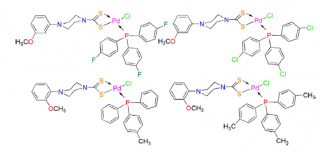Palldium(II) dithiocarbamates—anticancer metallodrugs of the future?

Most chemistry students are well aware of the anticancer properties of cisplatin, cis-Pt(NH3)2Cl2, as a result of the pioneering work of Professor Barnett Rosenberg and his colleagues at the Michigan State University in the late 1960s.
Over the years, this simple Pt(II) coordination complex and some structurally closely related ones have become the FDA-approved drugs of choice for cancer treatment, especially ovarian and testicular cancers. Unfortunately, cisplatin and these other Pt(II) complexes have serious unwanted side-effects, e.g., kidney and nerve damage, nausea and vomiting, and hearing loss, that have restricted their widespread clinical use.
Consequently, many research groups throughout the world have been searching for suitable alternative metallodrugs and palladium(II) dithiocarbamates have emerged as really promising candidates.
Together with his collaborators in Islamabad, Pakistan, one of whom, Professor Zia-ur-Rehman, worked partly on his Ph.D. thesis here in the Department of Chemistry, Professor Ian Butler has just published a timely review article on the anticancer potential, DNA-binding and DNA-denaturing abilities of a range of Pd(II) dithocarbamates – some of which were first prepared at McGill and, following clinical trials, may well prove to be valuable commercially in the treatment of a wide range of cancers in the future.
More information: Muhammad Kashif Amir et al. Anticancer activity, DNA-binding and DNA-denaturing aptitude of palladium(II) dithiocarbamates, Inorganica Chimica Acta (2016). DOI: 10.1016/j.ica.2016.06.036
Journal information: Inorganica Chimica Acta
Provided by McGill University

















